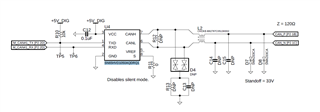Tool/software:
I'm working on a board where the CAN transceiver is being tested in isolation (benchtop 5V power applied for supply, no microcontroller connected to TX/RX so lines are being manually tied high/low to 5V/GND, nothing connected to bus pins, no cables or other devices). The TX input is pulled high to 5V, so when I measure the bus lines I see the expected recessive state voltages of ~2.2V.
However, when I manually connect TX (TP5 in this example) to ground for the transceiver to assert a dominant bus state there is no change in the bus voltages. It seems that the transceiver is not asserting a dominant state on the bus. I've verified at the pins of the transceiver that TX is 0V, that 5V power is being delivered, and that pin 8 is tied to 0V. The transceiver is clearly still functioning because the bus is in a recessive state.
The intended test was the verify the voltage levels with the transceiver asserting a dominant state, but it does not seem to be able to do so. Is there something missing from the setup, or else what could the cause of the issue be?


